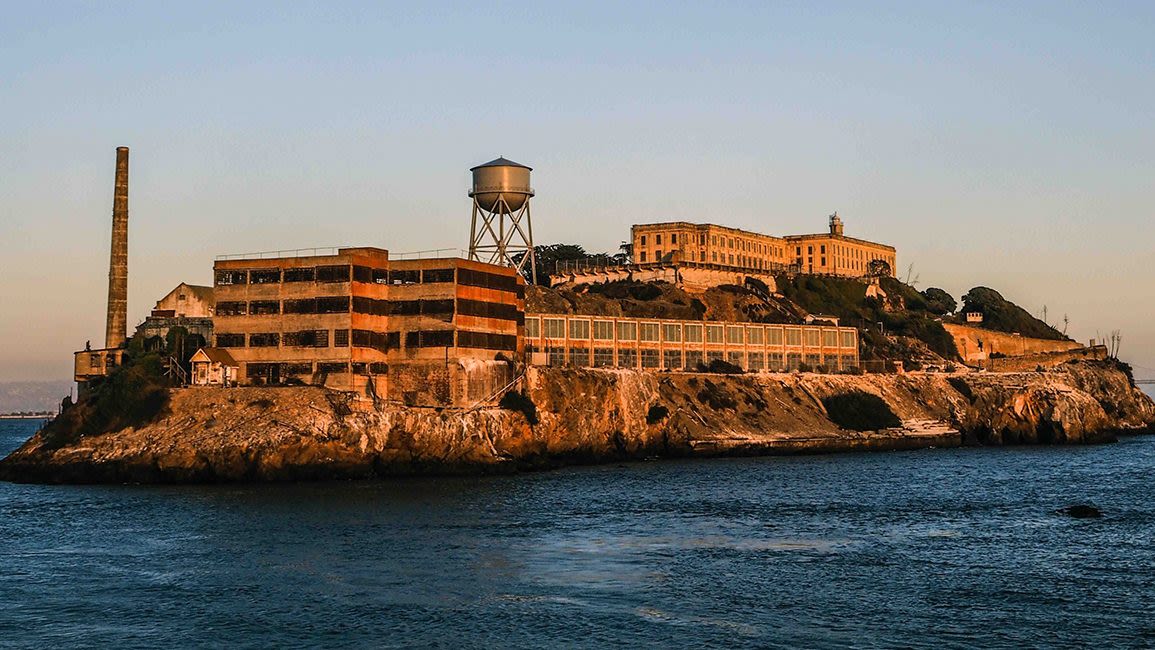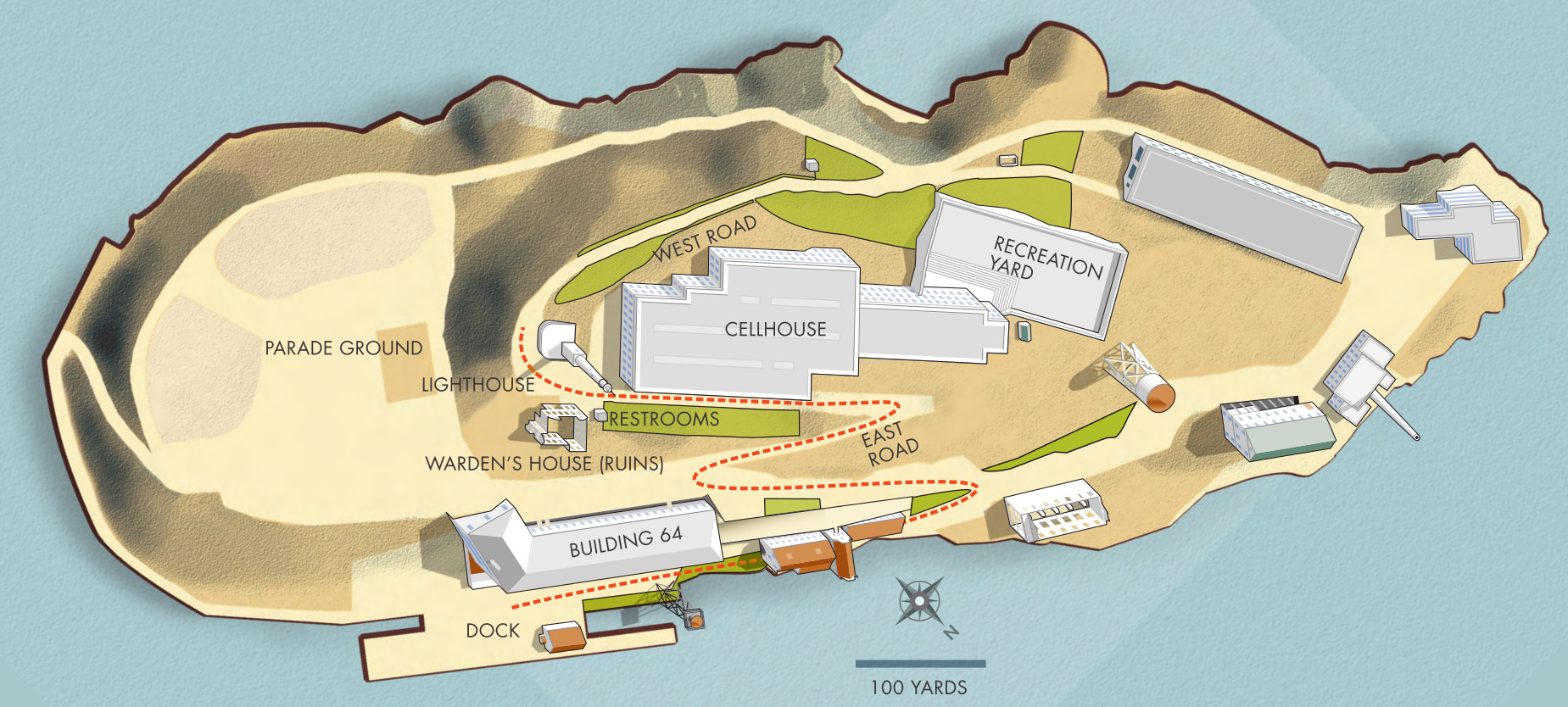.
[nextpage]Table of Contents
Found at Alcatraz Prison
Alcatraz Prison, often just called Alcatraz, is one of the most high-security prisons in the world. It is located on an island in San Francisco Bay that was developed with facilities for a lighthouse, a military prison, a military fortification, and a federal prison. Last year, researchers from Binghamton University, without doing any drilling or digging, discovered historical remains beneath the Alcatraz penitentiary by using high-tech laser and radar scans. They found a hidden military traverse buried beneath the island, and they were shocked to have found anything at all.
Click ‘Next’ to find out exactly what they discovered beneath the imposing Alcatraz Island…

The World’s Most Famous Prison
If you don’t know Alcatraz, then you’re in for quite a shock. Alcatraz Island, also called The Rock, occupies an area of 9 hectares, or 22 acres. It is located 2km off the shore of San Francisco, and it is one of the world’s most maximum-security prisons. When it was first explored in 1775, the island had almost no vegetation and was a habitat for seabirds. Lieutenant Juan Manuel de Ayala named it Isla de los Alcatraces, which means ‘Isle of the Pelicans’
.
[/nextpage][nextpage]Construction Begins
The island was sold to the United States government in 1849, and in 1854, it became the site for the first lighthouse on the coast of California. After that, several other buildings were constructed on the island, and in 1859, the first permanent army detachment was garrisoned there. In 1861, the island was designated as a residence for military criminals and offenders. The prisoners kept here would go on to include rebels and war criminals.
[/nextpage][nextpage]The Federal Prison Is Built
Some of Alcatraz Prison’s most famous prisoners include George ‘Machine Gun’ Kelly, Al Capone, and Robert Stroud, also called the ‘Birdman of Alcatraz’. He was also the focus of a film of the same title. While the penitentiary on Alcatraz Island was able to hold 450 convicts in cells that had measurements of around 10 x 4.5 feet, there were only ever around 250 prisoners on the island at once. Attempts at escaping were rare, but several inmates managed to escape successfully, which we’ll discuss shortly.
[/nextpage][nextpage]Native Americans Stake Their Claim
After the need to transport waste from the island and fresh water to the island resulted in it being abandoned, a group of Native Americans claimed the island as their own in 1964. They cited a treaty that was made in 1868 with the Sioux that allowed Indians from the reservation to claim any unoccupied government land. However, they only occupied the island for a few hours. In 1969, a group of Indian activists, which included some members from the American Indian Movement, occupied the island again.
[/nextpage][nextpage]An Escape From Alcatraz
To this day, the fate of three particular inmates remains a mystery. In 1962, a routine bed check that took place in the early morning turned into a disaster. Three convicts were not in their cells – Clarence Anglin, his brother John, and Frank Morris. In their beds were three cleverly constructed dummy heads made from plaster, paint, and human hair. The heads were so convincing that they fooled the guards. The prison was locked down, and a search began.
[/nextpage][nextpage]Gathering Clues
The FBI was notified and immediately provided assistance. The San Francisco office set leads for other offices around the country to find records of the missing prisoners, as well as all of their previous attempts to escape. The FBI also interviewed their relatives and gathered all of their ID records. They asked boat operators in the surrounding bay to check for debris in the water, and within two days, some letters related to the men were found.
[/nextpage][nextpage]Putting the Plan Together
As the investigation continued, the FBI, Bureau of Prison authorities, and the Coast Guard started to find more evidence and put the escapees’ plan together. They were aided by a fourth escapee who did not make it out of his cell in time and provided the FBI with information. They learned that the group started planning the escape in December of the previous year. They used crude tools to loosen the air vents at the back of their cells, made their way down a utility corridor, and even made their own life preservers for when they were in the water.
[/nextpage][nextpage]The Escape
On the evening of June 11, the escapees were ready. However, the prison informant did not completely remove his ventilator grill, and he was left behind. The others made it to the corridor, climbed out of the ventilator, and made it to the prison roof. They crawled down the smokestack of the bakery behind the cell house, scaled the fence, snuck to the shore of the island, and launched their raft. We have no idea what happened to them after that.
[/nextpage][nextpage]Uncovering the Mystery
Many people have tried their best to prove that the men who escaped Alcatraz were able to survive, but it is still unsure whether this is possible or not. While a few young people have made the long swim across the bay, the freezing water and strong currents make it extremely difficult. According to the prison informant, the plan was to steal a car and clothes once they’d reached land, but the FBI did not discover any crimes of that nature.
[/nextpage][nextpage]What You Actually Came Here For
That’s enough about the history and grand escapes from the world’s most famous prison, though. We’re going to talk about the thing that you actually clicked on this article for – what did scientists discover underneath Alcatraz? While the answer might not be as glamorous as a secret tunnel network for prisoners, it is certainly just as interesting, and if you’re a fan of history and archaeology, then you’re going to be quite intrigued.
[/nextpage][nextpage]Archaeologist Finds Hidden Military Traverse
Alcatraz Island’s military use has been recognized as historic for a long time, but the architectural remains from its time have remained mostly undiscovered because most of it was completely or partially destroyed when the prison was under construction. This means that there was very little left to discover of the military remains after the construction of the prison was complete, yet archaeologist Timothy de Smet managed to find something quite interesting.
[/nextpage][nextpage]The Power Of Technology
With some help from terrestrial laser scans, georectifications (the process of taking old maps, digitizing them, and linking them to a system of coordinates so that they may accurately be geolocated in 3-dimensional space), and ground-penetrating radar data, researchers could locate and test various historical remains that were buried beneath The Rock’s former recreation yard. The discoveries were quite interesting, and the best part is that the scientists did not have to do any drilling or digging.
[/nextpage][nextpage]What Was Discovered?
Timothy de Smet, with the help of his colleagues, uncovered various remnants of structures and buildings that had been buried for an extremely long time. They found a ‘bombproof’ earthwork traverse, as well as the underlying ventilation ducts and vaulted brick masonry tunnel. These tunnels ran from east to west, underneath the recreation yard that once belonged to Alcatraz Penitentiary. The archaeologists said that they were shocked to find that the historical structures were in good condition.
[/nextpage][nextpage]A Surprising Find
Timothy said that he was surprised for a number of reasons. The remains of the historical features of archaeology were a mere few centimeters beneath the surface. Somehow, they were incredibly preserved – to the archaeologists, it seemed like a miracle. The concrete veneer of the floor of the prison’s recreation yard is extremely thin and is sitting directly on top of the architecture from the 1860s. It was also discovered that some of the earthwork traverses were covered with a thin layer of concrete over time.
[/nextpage][nextpage]Alcatraz’s Military History
Alcatraz Island is most well-known as a former high-security federal. Today, it is a national historic landmark that continues to attract several tourists thanks to its location adjacent to the Golden Gate Bridge, which is another popular tourist destination. While people gravitate toward the island because of the abandoned prison, many people forget that it was once a coastal military fortification. It is important from a military history perspective, marking the transition from earthen structures to masonry.
[/nextpage][nextpage]Things Get Even More Interesting
The noninvasive process that the researchers used to uncover these pieces of history allows for accurate spatial identification of their findings, as well as other historic architectural structures that are depicted in historical documents. With this new breakthrough, the approach can now be applied to investigations below the surface of the earth at other important, cultural landmarks around the world. Timothy said that the results are proof that archaeologists are able to find historical structures without digging or drilling.
[/nextpage][nextpage]A Breakthrough In Archaeology

With modern methods of remote sensing, like the one used to make this incredible discovery, archaeologists are now able to answer some of the most fundamental research questions in archaeology regarding human behavior, cultural change over time, and social organization. The best part is that all of this can be done without destructive and costly excavation, which preserves these non-renewable archaeological resources. These are significant results, as they demonstrate how modern technology can be used to answer fundamental questions.
[/nextpage][nextpage]Looking Forward
Timothy de Smet hopes to conduct even more research on this topic, and at the moment, he is preparing a manuscript that will be submitted to the Journal of Cultural Heritage. The manuscript focuses on ground-penetrating radar and terrestrial laser scans from the remnants of the former Citadel that is found buried underneath the prison. Hopefully, de Smet can inspire archaeologists around the world to use these non-invasive, non-destructive methods of excavating to discover new archaeological wonders.
[/nextpage][nextpage]The Value Of Archaeology
When people think of archaeology, they often visualize exotic images. We think of cliff dwellings, pyramids, and incredible, golden artifacts that one might see in an Indiana Jones film. While all of these things are familiar, they are so compelling that they often disguise one fact of archaeology that is essential to understand. Every place is important, and every place has a past. There are different fields in archaeology, and each is devoted to uncovering history in different ways and in different places.
[/nextpage][nextpage]Why Archaeology Is Important
The goal of archaeology is to understand why and how human behavior changed over time. Archaeologists look for evolutionary patterns in important cultural events, like the invention of farming, the creation of cities, or major civilization collapses. They look for clues as to why these things happen and are ultimately searching for ways to predict how cultures will change, including our own cultures, and how we can properly plan for the future.
[/nextpage][nextpage]How It Helps
In the case of the Alcatraz archaeologists, they were able to discover military construction beneath the surface of Alcatraz Prison’s recreational grounds, and they did it without doing any harmful excavations, digging, or drilling. This not only proves that archaeology is an important field of study and science, but it is also able to help preserve some of the most cultural historic sites in the world.
[/nextpage][nextpage]How Do Archaeologists Study the Past?
Archaeological sites are evidence of human activity that are generally associated with a number of artifacts. Excavating these sites is often a destructive process that requires artifacts and soils to be systematically removed. These sites are also similar to research labs, as they are used to collect, record, and study data. Archaeologists study patterns in their findings and use them to determine how humanity changed in the past and how it might change in the future.
[/nextpage][nextpage]Preserving the Past
When an archaeologist discovers a historical site, an artifact, or any other item that might be of historical interest, it is up to them to uncover and study it. There are several laws that dictate who can dig up an artifact, where the digging can occur, and how the digging takes place. The archaeologists do their best to dig up artifacts in a gentle fashion, so as not to damage them and to preserve them as much as possible.
[/nextpage][nextpage]Archaeology Matters
Archaeological sites are non-renewable resources, which means that, after they have been excavated or destroyed, they are gone and cannot be replaced. This is a significant loss. At the end of the day, archaeology is not about excavations, artifacts, or exhibits, but rather about people. The decisions we make about the future are based on the lessons we learn in the past. That’s why archaeology is so important!
[/nextpage]